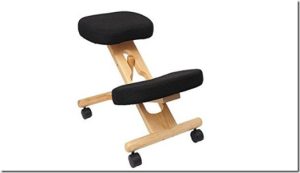
My project to build an ergonomic kneeling chair has been one of the most popular items on the blog. This page is a summary to identify the various separate articles involved in the project.
Note that this kneeling chair is made out of metal, not wood. The finished article is absolutely bomb-proof.
The separate articles are listed below:
- Welding Isn’t Easy! (Introduction)
- Project #1
- Project #1 (Update)
- Project #2
- Project #3
- Project #3 (Update)
- Project #4
Follow each stage in sequence.
Someone asked me what size bolts I used. I didn’t include that information in my drawings – I think I assumed that the diameter of the holes was enough, but I should have explained more clearly. In fact, the bolt size doesn’t matter as long as you don’t make your holes so large that the structure is weakened, or use such small bolts that these themselves become the weak point. Mine were two sizes – the ones used to link the struts were about 5/16″ (or 8mm); the ones elsewhere were about 3/16″ (or 4.5mm). I bought them online.
Someone else asked if the drawings could be used to make the chair out of wood using 2x2s and 2x3s. The short answer is no – because the strain on the part where the struts join the feet would be so great that the assembly would split (and even wooden ones you buy suffer from this problem, which is why I went for metal if you remember the introductory article). I suppose you could modify my plans and develop a functional wooden chair, but that is beyond the scope of this series.
I should also clarify that the kneeling chair I built used three parts left over from the last one I bought: the seat and knee pad panels, and the raising mechanism.
The pad panels are just bean-shaped plywood with threaded mounting holes in them. I re-upholstered them using foam and fabric purchased online (detailed in the articles). However, if you were building one from scratch it would be a simple matter to make your own panels for the seat and knee pads using ¼” or ½” plywood. The raising mechanism would be a little more of a challenge, but still fairly simple to construct. All it consists of is a threaded shaft inside a corresponding threaded socket. When the shaft is turned the overall length of the socket/thread assembly either increases or decreases. Since the ends of this assembly are fixed to the support struts of the chair, the seat rises or falls as the thread is turned.